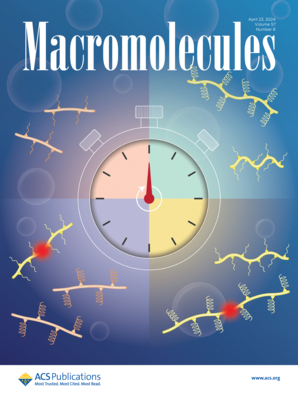Analyzing QCM Data Using a New Transfer-Matrix Model: Long-Ranged Asymmetric Gradient in Shear Modulus Identified Across Immiscible Glassy–Rubbery Polymer Interface
IF 5.1
1区 化学
Q1 POLYMER SCIENCE
引用次数: 0
Abstract
A new approach to analyzing quartz crystal microbalance (QCM) data using an acoustic transfer-matrix model is presented that enables determining a local depth-dependent shear modulus G̃(z) profile. A strong decrease in dissipation upon annealing is observed for immiscible polymer bilayer films of rubbery polybutadiene (PB) atop glassy polystyrene (PS), reflecting large viscoelastic changes in the sample corresponding to the emergence of a broad gradient in modulus G̃(z) when the ≈5 nm compositional interface is formed. Using a new transfer-matrix form of our continuum mechanics model that matches boundary conditions of shear waves between discrete modeled layers, we computationally fit these changes in frequency Δf(n) and dissipation ΔΓ(n) shifts over a range of harmonics n to the evolution of a modulus gradient. The G̃(z) gradient across the PS/PB bilayer, treated as a hyperbolic tangent, is observed to be broad (230 nm) and strongly asymmetric (200 nm) toward the glassy PS side, consistent with the general trends of local glass transition Tg(z) previously reported. Surprisingly, the G̃(z) gradient is found to be symmetric on a log G scale, with the value of G at the interface equivalent to the geometric mean that optimizes acoustic energy transmission.

求助全文
约1分钟内获得全文
求助全文
来源期刊

Macromolecules
工程技术-高分子科学
CiteScore
9.30
自引率
16.40%
发文量
942
审稿时长
2 months
期刊介绍:
Macromolecules publishes original, fundamental, and impactful research on all aspects of polymer science. Topics of interest include synthesis (e.g., controlled polymerizations, polymerization catalysis, post polymerization modification, new monomer structures and polymer architectures, and polymerization mechanisms/kinetics analysis); phase behavior, thermodynamics, dynamic, and ordering/disordering phenomena (e.g., self-assembly, gelation, crystallization, solution/melt/solid-state characteristics); structure and properties (e.g., mechanical and rheological properties, surface/interfacial characteristics, electronic and transport properties); new state of the art characterization (e.g., spectroscopy, scattering, microscopy, rheology), simulation (e.g., Monte Carlo, molecular dynamics, multi-scale/coarse-grained modeling), and theoretical methods. Renewable/sustainable polymers, polymer networks, responsive polymers, electro-, magneto- and opto-active macromolecules, inorganic polymers, charge-transporting polymers (ion-containing, semiconducting, and conducting), nanostructured polymers, and polymer composites are also of interest. Typical papers published in Macromolecules showcase important and innovative concepts, experimental methods/observations, and theoretical/computational approaches that demonstrate a fundamental advance in the understanding of polymers.
 求助内容:
求助内容: 应助结果提醒方式:
应助结果提醒方式:


